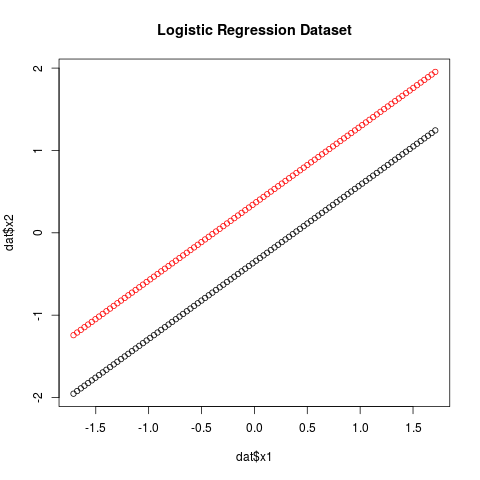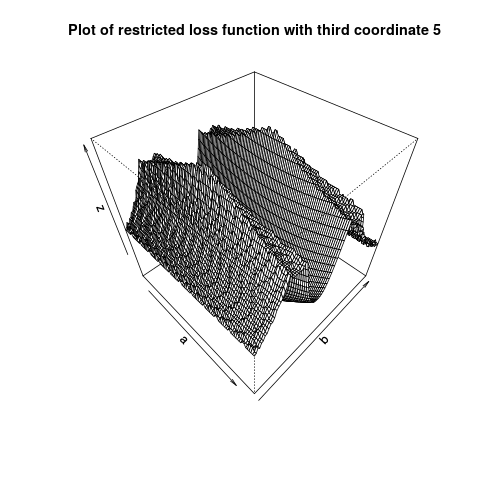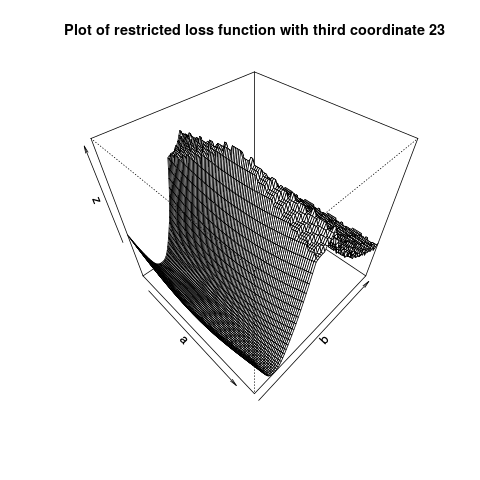I know that logistic regression is a convex problem. Furthermore, from Lemma 1.17 in these optimization lecture notes, if a function $f : \mathbb{R}^n \rightarrow \mathbb{R}$ is convex, then the function over a restricted domain (as it were) should be convex. For example, if $f(x,y,z)$ is convex, then $g(x,y) = f(x,y,2)$ should be convex (assuming $f$ is defined at $z=2$), right?
However, I have been experimenting with my own implementation of logistic regression and have found that the loss function (ie opposite of log-likelihood) is not convex. All my code is at the bottom
I have created the following fake dataset which can be perfectly classified:
I defined a loss function as the negative log likelihood, scaled by $1/n$:
$$ L(\beta) = - \frac{1}{n}\sum_{i=1}^{n} y_i \log(p_i) + (1-y_{i})\log(1-p_i) $$
where
$$p_i = \dfrac{\exp(\beta_0 + \beta_1 x_{1i} + \beta_2 x_{2i})}{1+\exp(\beta_0 + \beta_1 x_{1i} + \beta_2 x_{2i})}$$
My optimization function gives the following solution (which seems to be right because it can perfectly classify the data),
$$\hat{\mathbf{\beta}} = (0, -20, 23)$$
If I plot the loss function at a fixed value of the third parameter $g(a,b) = L( (a, b, 23)$, it does not appear convex. I have tried this for multiple values of the third parameter.
What is going on here?
#
# Create dataset
#
x1 <- rep(seq(1, 10, length = 100),2)
x2 <- c(x1[1:100]+3 , x1[101:200]+5)
# Scale
x1 <- scale(x1)
x2 <- scale(x2)
# Store in data frame
dat <- data.frame(x1 = x1, x2 = x2,
y = c(rep(0, 100), rep(1,100))
)
# Plot
plot(dat$x1, dat$x2, col = dat$y + 1, main = "Logistic Regression Dataset")
#
# Loss Function
#
sigmoid <- function(a){
sapply(a, function(arg){
if(arg > 18){return(1)}
if(arg < -18){return(0)}
return(1/(1+exp(-arg)))
})
}
# A log function that is zero when its argument is zero, not -Inf
log0 <- function(a){
sapply(a, function(arg){
if(arg==0){return(0)}
return(log(arg))
})
}
loss <- function(y,x,w){
# x a matrix with unity first col, w a vector
if(all(x[,1] == 1) == FALSE){
stop("first column of x must be unity")
}
# Compute vector of dot products
sigmoid.dot <- sigmoid(x %*% w)
# Compute elementwise loss
li <- y*log0(sigmoid.dot)+(1-y)*log0(1-sigmoid.dot)
#
# Take negative average and return
#
return(-mean(li))
}
#
#OMITTING SOLLUTION CODE
# PROVE THAT IT WORKS:
X <- cbind(rep(1, nrow(dat)), dat$x1, dat$x2)
w <- c(0,-20, 23)
preds <- ifelse(sigmoid(X %*% w) > 0.5, 1, 0)
table(preds, dat$y)
#
# Plot the loss
#
lossPlot <- function(d){
lossf <- function(a,b){
w <- c(a, b, d)
return(loss(dat$y, X, w))
}
a <- seq(-5, 5, length = 100)
b <- seq(-30, 30, length = 100)
z <- matrix(nrow = 100, ncol = 100)
for(ii in 1:100){
for(jj in 1:100){
z[ii,jj] <- lossf(a[ii],b[jj])
}
}
persp(a,b,z, phi = 45, theta = 45,
main = paste("Plot of restricted loss function with third coordinate", d)
)
}
lossPlot(5)
lossPlot(23)
Thanks!



